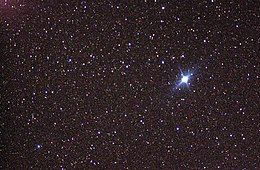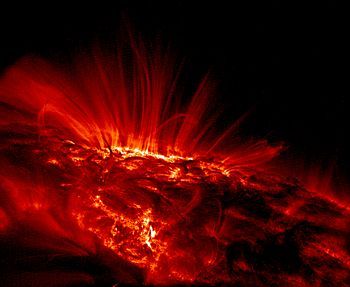Portal:Stars
IntroductionA star is a luminous spheroid of plasma held together by self-gravity. The nearest star to Earth is the Sun. Many other stars are visible to the naked eye at night; their immense distances from Earth make them appear as fixed points of light. The most prominent stars have been categorised into constellations and asterisms, and many of the brightest stars have proper names. Astronomers have assembled star catalogues that identify the known stars and provide standardized stellar designations. The observable universe contains an estimated 1022 to 1024 stars. Only about 4,000 of these stars are visible to the naked eye—all within the Milky Way galaxy. A star's life begins with the gravitational collapse of a gaseous nebula of material largely comprising hydrogen, helium, and trace heavier elements. Its total mass mainly determines its evolution and eventual fate. A star shines for most of its active life due to the thermonuclear fusion of hydrogen into helium in its core. This process releases energy that traverses the star's interior and radiates into outer space. At the end of a star's lifetime as a fusor, its core becomes a stellar remnant: a white dwarf, a neutron star, or—if it is sufficiently massive—a black hole. Stellar nucleosynthesis in stars or their remnants creates almost all naturally occurring chemical elements heavier than lithium. Stellar mass loss or supernova explosions return chemically enriched material to the interstellar medium. These elements are then recycled into new stars. Astronomers can determine stellar properties—including mass, age, metallicity (chemical composition), variability, distance, and motion through space—by carrying out observations of a star's apparent brightness, spectrum, and changes in its position in the sky over time. Stars can form orbital systems with other astronomical objects, as in planetary systems and star systems with two or more stars. When two such stars orbit closely, their gravitational interaction can significantly impact their evolution. Stars can form part of a much larger gravitationally bound structure, such as a star cluster or a galaxy. (Full article...) Selected star - Photo credit: NASA
Canopus (/kəˈnoʊpəs/; α Car, α Carinae, Alpha Carinae) is the brightest star in the southern constellation of Carina, and the second brightest star in the night-time sky, after Sirius. Canopus's visual magnitude is −0.72, and it has an absolute magnitude of −5.65. Canopus is a supergiant of spectral type F. Canopus is essentially white when seen with the naked eye (although F-type stars are sometimes listed as "yellowish-white"). It is located in the far southern sky, at a declination of −52° 42' (2000) and a right ascension of 06h24.0m. Its name comes from the mythological Canopus, who was a navigator for Menelaus, king of Sparta. Canopus is the most intrinsically bright star within approximately 700 light years, and it has been the brightest star in Earth's sky during three different epochs over the past four million years. Other stars appear brighter only during relatively temporary periods, during which they are passing the Solar System at a much closer distance than Canopus. About 90,000 years ago, Sirius moved close enough that it became brighter than Canopus, and that will remain the case for another 210,000 years. But in 480,000 years, Canopus will once again be the brightest, and will remain so for a period of about 510,000 years. Selected article - Photo credit: User:LCGS Russ
A circumpolar star is a star that, as viewed from a given latitude on Earth, never sets (that is, never disappears below the horizon), due to its proximity to one of the celestial poles. Circumpolar stars are therefore visible from said location towards nearest pole for the entire night on every night of the year (and would be continuously visible throughout the day too, were they not overwhelmed by the Sun's glare). All circumpolar stars are within the circumpolar circle. This was in fact the original meaning of "Arctic Circle", before the current geographical meaning, meaning "Circle of the Bears" (Ursa Major, the Great Bear; and Ursa Minor, the Little Bear), from Greek αρκτικός (arktikos), "near the Bear", from the word άρκτος (arktos) bear. As Earth spins daily on its axis, the stars appear to rotate in circular paths around one of the celestial poles (the north celestial pole for observers in the Northern Hemisphere, or the south celestial pole for observers in the Southern Hemisphere). Stars far from a celestial pole appear to rotate in large circles; stars located very close to a celestial pole rotate in small circles and hence hardly seem to engage in any diurnal motion at all. Depending on the observer's latitude on Earth, some stars — the circumpolar ones — are close enough to the celestial pole to remain continuously above the horizon, while other stars dip below the horizon for some portion of their daily circular path (and others remain permanently below the horizon). The circumpolar stars appear to lie within a circle that is centered at the celestial pole and tangential to the horizon. At the Earth's North Pole, the north celestial pole is directly overhead, and all stars that are visible at all (that is, all stars in the northern celestial hemisphere) are circumpolar. As one travels south, the north celestial pole moves towards the northern horizon. More and more stars that are at a distance from it begin to disappear below the horizon for some portion of their daily "orbit", and the circle containing the remaining circumpolar stars becomes increasingly small. At the Earth's equator this circle vanishes to a single point – the celestial pole itself – which lies on the horizon, and there are therefore effectively no circumpolar stars at all. Selected image - Photo credit: NASA/TRACE
Sunspots are temporary phenomena on the surface of the Sun (the photosphere) that appear visibly as dark spots compared to surrounding regions. They are caused by intense magnetic activity, which inhibits convection, forming areas of reduced surface temperature. Although they are at temperatures of roughly 3,000–4,500 K, the contrast with the surrounding material at about 5,780 K leaves them clearly visible as dark spots, as the intensity of a heated black body (closely approximated by the photosphere) is a function of T (temperature) to the fourth power. If the sunspot were isolated from the surrounding photosphere it would be brighter than an electric arc. Sunspots expand and contract as they move across the surface of the sun and can be as large as 80,000 km (50,000 miles) in diameter, making the larger ones visible from Earth without the aid of a telescope. Did you know?
SubcategoriesTo display all subcategories click on the ►
Selected biography - Photo credit: Eduard Ender
Tycho Brahe, born Tyge Ottesen Brahe (de Knudstrup) (14 December 1546 – 24 October 1601), was a Danish nobleman known for his accurate and comprehensive astronomical and planetary observations. Coming from Scania, then part of Denmark, now part of modern-day Sweden, Tycho was well known in his lifetime as an astronomer and alchemist. His Danish name "Tyge Ottesen Brahe" is pronounced in Modern Standard Danish as [ˈtsʰyːə ˈʌtəsn̩ ˈpʁɑːə]. He adopted the Latinized name "Tycho Brahe" (usually /ˈtaɪkoʊ ˈbrɑː/ or /ˈbrɑːhiː/ in English) from Tycho (sometimes written Tÿcho) at around age fifteen, and he is now generally referred to as "Tycho", as was common in Scandinavia in his time, rather than by his surname "Brahe". (The incorrect form of his name, Tycho de Brahe, appeared only much later. Tycho Brahe was granted an estate on the island of Hven and the funding to build the Uraniborg, an early research institute, where he built large astronomical instruments and took many careful measurements. After disagreements with the new king in 1597, he was invited by the Bohemian king and Holy Roman emperor Rudolph II to Prague, where he became the official imperial astronomer. He built the new observatory at Benátky nad Jizerou. Here, from 1600 until his death in 1601, he was assisted by Johannes Kepler. Kepler later used Tycho's astronomical information to develop his own theories of astronomy.
TopicsThings to do
Related portalsAssociated WikimediaThe following Wikimedia Foundation sister projects provide more on this subject:
Discover Wikipedia using portals |

























